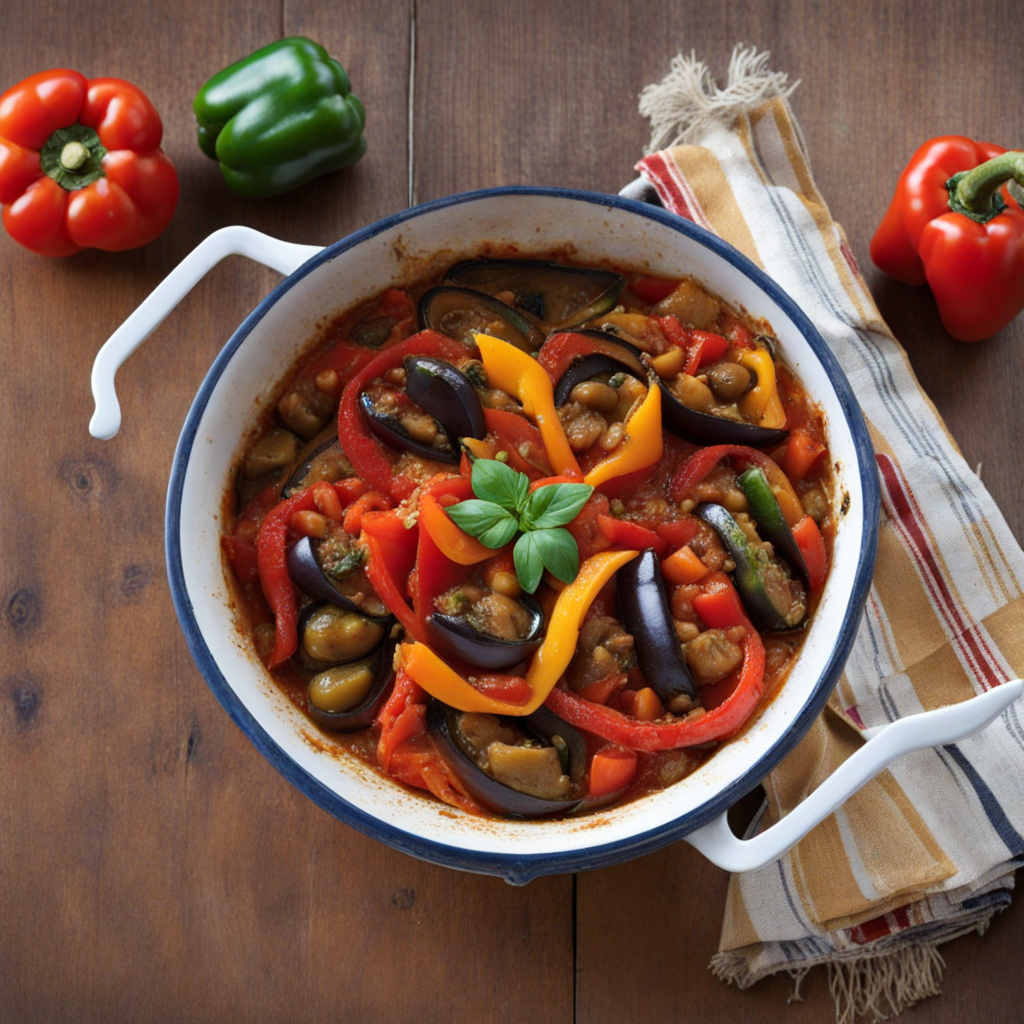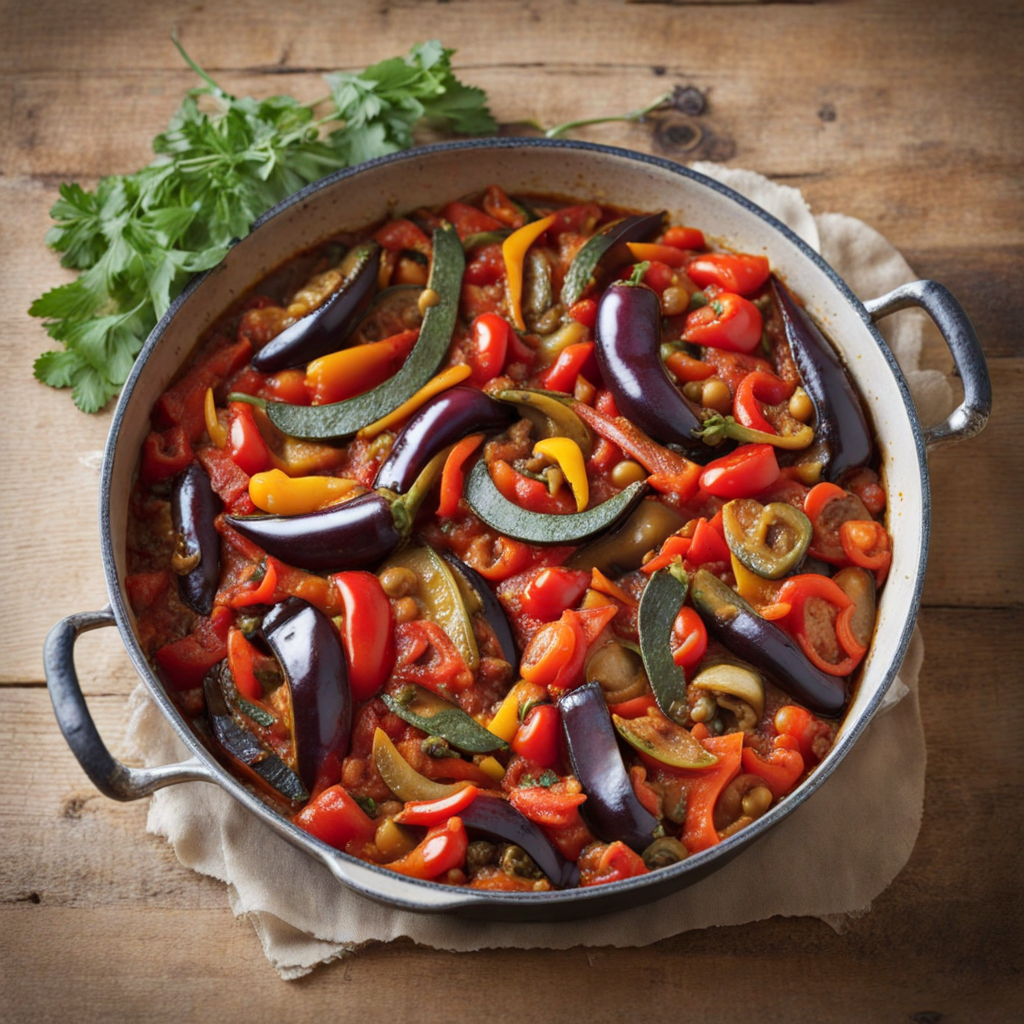Kapunata
Kapunata is a vibrant Maltese dish that showcases the island's Mediterranean flavors and culinary traditions. At its core, this ratatouille-like stew is made with a generous mix of fresh vegetables, primarily eggplants, bell peppers, zucchini, tomatoes, and onions. These ingredients are typically sautéed in olive oil, which is a staple in Maltese cuisine, allowing the vegetables to soften and meld together. The addition of capers and olives introduces a delightful brininess, while fresh herbs like basil and parsley enhance the dish's aromatic profile. The result is a colorful, hearty dish that captures the essence of summer in Malta, making it a perfect accompaniment to various main courses or even enjoyed on its own with crusty bread. One of the most appealing aspects of Kapunata is its versatility. While the traditional recipe remains a beloved classic, many Maltese families have their own variations, adding personal touches that reflect their tastes and preferences. Some may incorporate additional ingredients like potatoes or chickpeas for added texture and heartiness, while others might sprinkle in a dash of chili flakes for a subtle kick. Kapunata can be served warm or cold, making it an excellent choice for picnics or potlucks, where its flavors can develop even further as it sits. The dish is not just a feast for the palate but also a celebration of seasonal produce. Each bite of Kapunata is a reminder of Malta's rich agricultural heritage, where local farmers take pride in growing organic vegetables under the Mediterranean sun. This connection to the land is evident in the freshness and quality of the ingredients used. As you savor each spoonful, you'll find yourself transported to the rugged landscapes and sun-kissed shores of Malta, where every meal is a testament to the island's rich culinary history and the simple joys of sharing food with loved ones.
How It Became This Dish
The History of Kapunata: A Culinary Gem of Malta #### Origins of Kapunata Kapunata, a beloved dish from Malta, is a vibrant vegetable stew that reflects the island's rich culinary heritage influenced by various cultures over the centuries. The name "kapunata" derives from the Sicilian "capunata," a dish that shares similarities with the Italian caponata, a sweet and sour eggplant dish. This etymological connection hints at the historical relationship between Malta and Sicily, which has been a significant factor in the development of Maltese cuisine. The origins of kapunata can be traced back to the Mediterranean’s agricultural bounty, where local ingredients such as eggplants, tomatoes, bell peppers, onions, and capers form the base of this dish. This combination showcases the island's favorable climate for growing a variety of vegetables, which were staples in the diets of Maltese families. #### Cultural Significance Kapunata is more than just a dish; it is a symbol of Malta's agrarian roots and communal life. Traditionally made during the summer months when fresh produce is abundant, kapunata embodies the values of sharing and hospitality. Families often gather to prepare the dish, passing down recipes and techniques from generation to generation. It is also common for kapunata to be served at festive occasions and family gatherings, reinforcing its status as comfort food within Maltese culture. The preparation of kapunata is a labor of love, involving the meticulous chopping and sautéing of vegetables, followed by the addition of local spices and a drizzle of olive oil. The communal aspect of cooking this dish speaks to the Mediterranean tradition of sharing meals with loved ones, fostering connections and celebrating life’s milestones. #### Development Over Time As Malta has evolved, so too has kapunata. The dish has absorbed influences from various cultures due to Malta's strategic location in the Mediterranean, a crossroads for trade, migration, and conquest. The Phoenicians, Romans, Arabs, Normans, Knights of St. John, and British have all left their mark on Maltese cuisine, and kapunata is no exception. The Arab influence on Maltese cooking is particularly noteworthy, as it introduced new ingredients like spices, almonds, and citrus fruits, which have found their way into many traditional dishes, including kapunata. The use of vinegar and the inclusion of sweet and sour elements in the dish can also be traced back to Arabic culinary practices, which emphasized balancing flavors. In the 18th and 19th centuries, with the establishment of Malta as a British colony, the introduction of new vegetables and preservation methods further transformed kapunata. The British influence led to an increased availability of canned goods, which allowed kapunata to be enjoyed year-round, even when fresh ingredients were not as accessible. Today, kapunata is often compared to ratatouille, a French vegetable dish, yet it maintains its unique Maltese identity. While traditional recipes still prevail, modern interpretations have emerged, with chefs experimenting by incorporating local seafood or introducing new spices, reflecting contemporary tastes while honoring the dish’s heritage. #### Regional Variations As with many traditional dishes, regional variations of kapunata exist across the Maltese islands, including Gozo, Malta's sister island. Gozitan kapunata may be heartier, often incorporating local ingredients such as goat cheese or a variety of herbs unique to the island. These variations highlight the diversity of Maltese cuisine and the adaptability of kapunata to local palates and available resources. #### Contemporary Significance In recent years, there has been a resurgence of interest in traditional Maltese cuisine, driven by a growing awareness of the importance of local ingredients and sustainable cooking practices. As the farm-to-table movement gains traction, many chefs are returning to traditional recipes and methods, including kapunata, which is often featured on menus at restaurants that emphasize Maltese heritage and the use of seasonal produce. Kapunata is also becoming increasingly popular in the global food scene, thanks to the rise of vegetarian and plant-based diets. Its wholesome ingredients and flexibility make it an appealing choice for health-conscious diners. Moreover, the dish’s rich history and cultural significance resonate with those seeking authentic culinary experiences, making kapunata a culinary ambassador for Malta on the international stage. #### Serving and Enjoying Kapunata Traditionally, kapunata is served warm or at room temperature, making it an ideal dish for sharing. It can be enjoyed as a main course, accompanied by crusty bread or as a side dish alongside grilled meats or fish. Some people prefer to serve it alongside a dollop of ricotta or a sprinkle of feta cheese, enhancing its creamy texture and flavor profile. In Maltese households, kapunata is often prepared in large batches, encouraging family and friends to gather around the table and share stories over a hearty meal. This communal dining experience is a testament to the dish's role in fostering relationships and creating lasting memories. #### Conclusion Kapunata is a quintessential representation of Malta’s culinary heritage, encapsulating the island's agricultural richness, cultural influences, and communal values. Its evolution over time reflects the resilience and adaptability of Maltese cuisine, while its enduring popularity underscores its significance in both traditional and contemporary settings. As Malta continues to embrace its gastronomic roots, kapunata remains a beloved dish that not only nourishes the body but also connects generations, celebrating the flavors and stories of the island. Whether enjoyed at a family gathering or a high-end restaurant, kapunata is a dish that invites everyone to partake in the rich tapestry of Maltese culture, one flavorful bite at a time.
You may like
Discover local flavors from Malta







